How I Study
I used to be a C student for all of my life until 10th grade when I became the top student in my school, got accepted into an Ivy League university (didn’t attend though), and have been the top of my class in my university so far. I didn’t suddenly get the discipline to study many more hours, I just figured out the most effective way to study and still have time for other things.
I built a system for studying that enabled me to get good grades while having the time for everything else I want to do. I found asymmetric techniques that take a small amount of time but make you learn much faster and more effectively.
I use Obsidian for note-taking and it has unlocked amazing things for me. I prefer Obsidian over notion because it has:
- Markdown files in your own computer (which you can upload to ChatGPT)
- Better ability to link notes
- Everything is a note and is linkable (pdfs, daily notes, etc.)
- Rich community plugin ecosystem.
- and it’s much faster than Notion.
How everyone studies and why it’s wrong
Most people in my class don’t even have notes. They don’t even download the slides to their own computer. A couple days before the exam when they want to study, they go to Blackboard, open the slide there and just read the slides. I don’t know how they expect to perform well by doing that. Plainly reading something is proved to lead to the lowest retention. You won’t remember most of what you read in the slides when you have to take the exam.
Other students who are a little more serious use something like Google Docs or Microsoft Word to take notes. They create a doc for a class and write notes session by session.

The problem here is that you are organizing your notes by the session it was taught, not the actual topics you want to learn. You are studying the sessions, not the topics. If something in session 27 builds on top of something in session 3, you won’t see the connection.
Instead, your notes should be organized by topics and show how they build on top of each other. That’s where the Zettelkasten system in Obsidian comes in.
The Zettelkasten System in Obsidian
Even though it has a strange name, the Zettelkasten is pretty basic. Each note contains one concept. It’s called an “Atomic Note”. You can then link these atomic notes, creating a web of knowledge where you can easily see how different concepts relate to each other. Obsidian makes it super easy to do and visualize this.
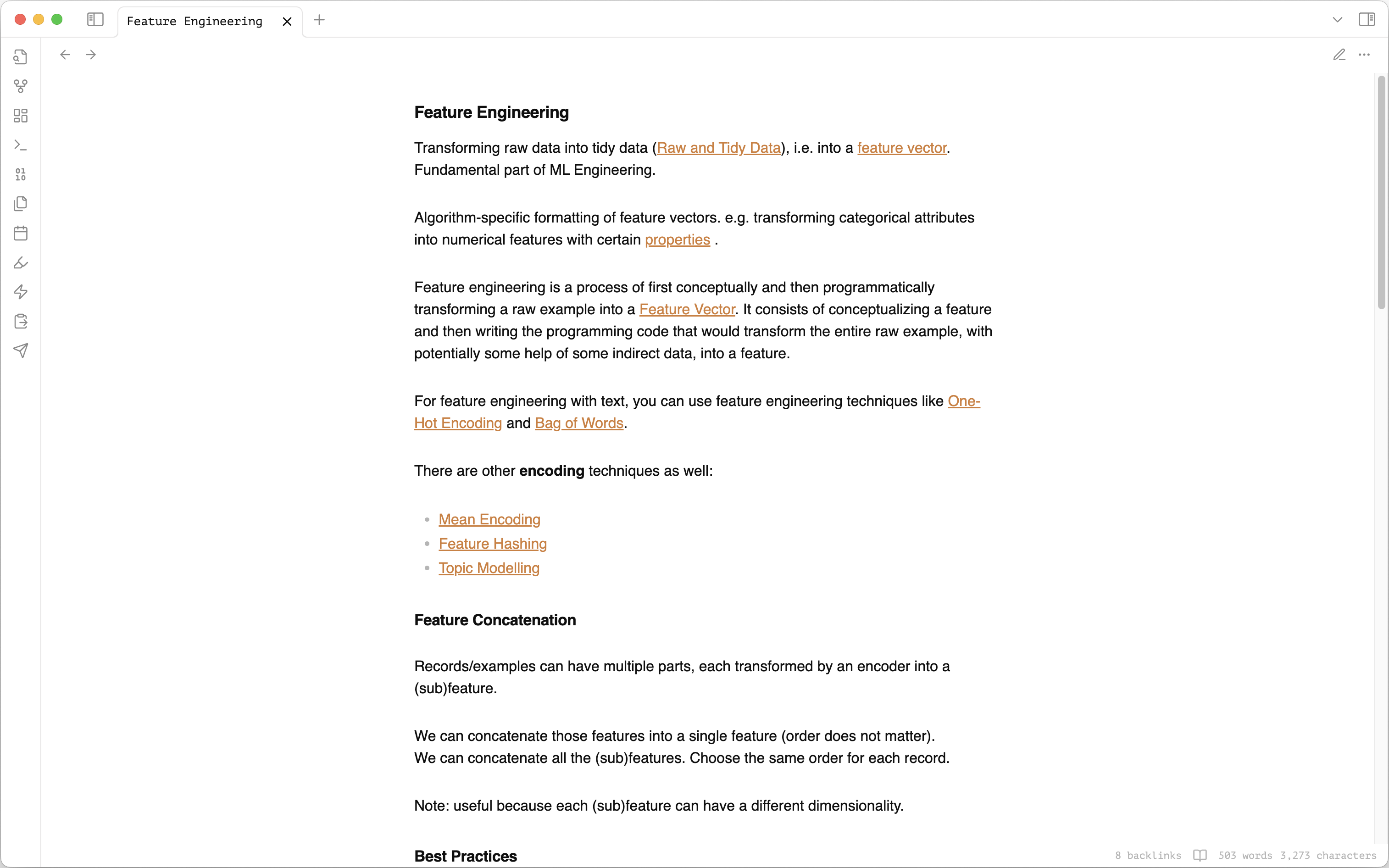
This is one of my notes from my Machine Learning Foundations class. I don’t know which session it was taught in. In fact, many different parts of it were taught in different sessions. I don’t care which sessions they were taught in. I care about understanding Feature Engineering.
The orange underlined items are links to other notes. If I’m studying Feature Engineering and I forgot what a Feature Vector was, I just click on it to revise, and then come back and continue.
At the bottom of the note in Obsidian, I can see all notes that link to Feature Engineering.
This lets me see where Feature Engineering is used to connect the dots between everything I’m learning and understand everything better. This makes it much easier to remember everything for exams since you deeply understand how everything connects to each other and why.
Obsidian gives you a graph view of how all your notes connect which is also pretty cool.
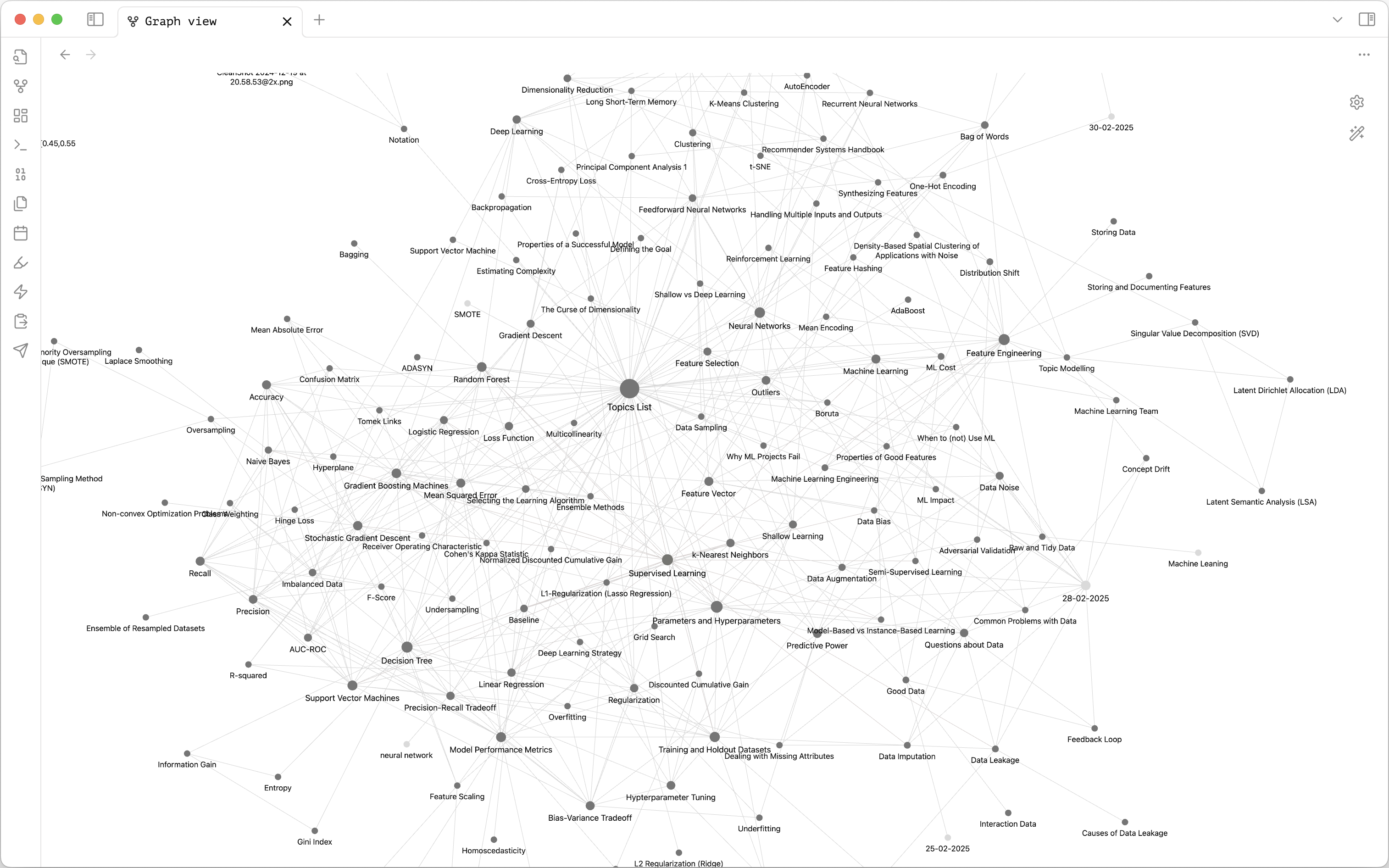
Just using this system makes studying much easier, efficient, and effective. But, how do you make sure you remember all of this stuff by the time you have to take your exams?
Spaced Repetition
Even if you use this Zettelkasten system, if you only start studying the day before the exam, you’re still screwed. You have to study regularly. That’s where spaced repetition comes in.
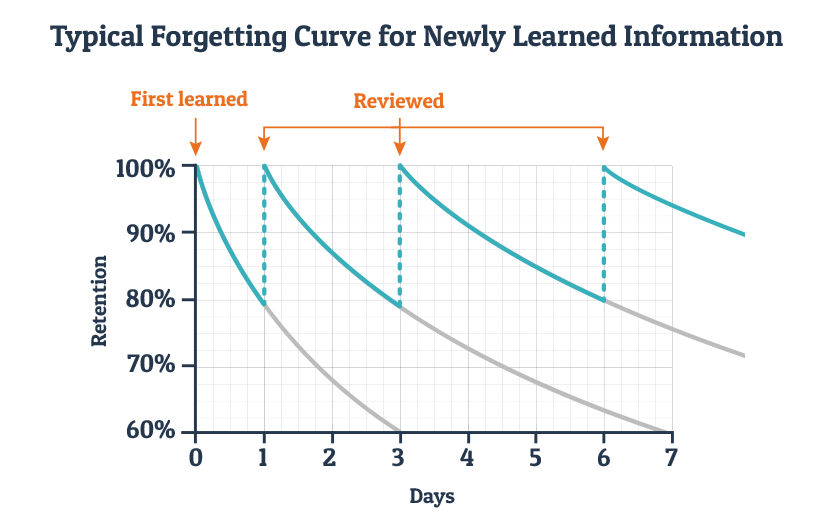 I’m not gonna explain the science of spaced repetition. It just works. Every time you study something, you will remember it for more time. If you space out your studying during the whole semester, you will never have to grind.
I’m not gonna explain the science of spaced repetition. It just works. Every time you study something, you will remember it for more time. If you space out your studying during the whole semester, you will never have to grind.
This actually feels like a cheat code. When exam season starts, I see everyone go to the library in the morning and leave at night. Equipped with coffee, zyn, and adderall. Their brains are fried. Meanwhile, I casually review some notes in Obsidian and get a better grade than them. Just because studied regularly during the whole semester.
I use Obsidian to organize my spaced repetition schedule “automatically”. Here’s how:
Obsidian lets you add properties to your notes. I added 3 properties to track when I study a topic:
- Last Studied: The last time I studied the topic.
- Last Score: How well I understood/remembered the topic the last time I studied it
- Next Study: The day I have to study this topic again.
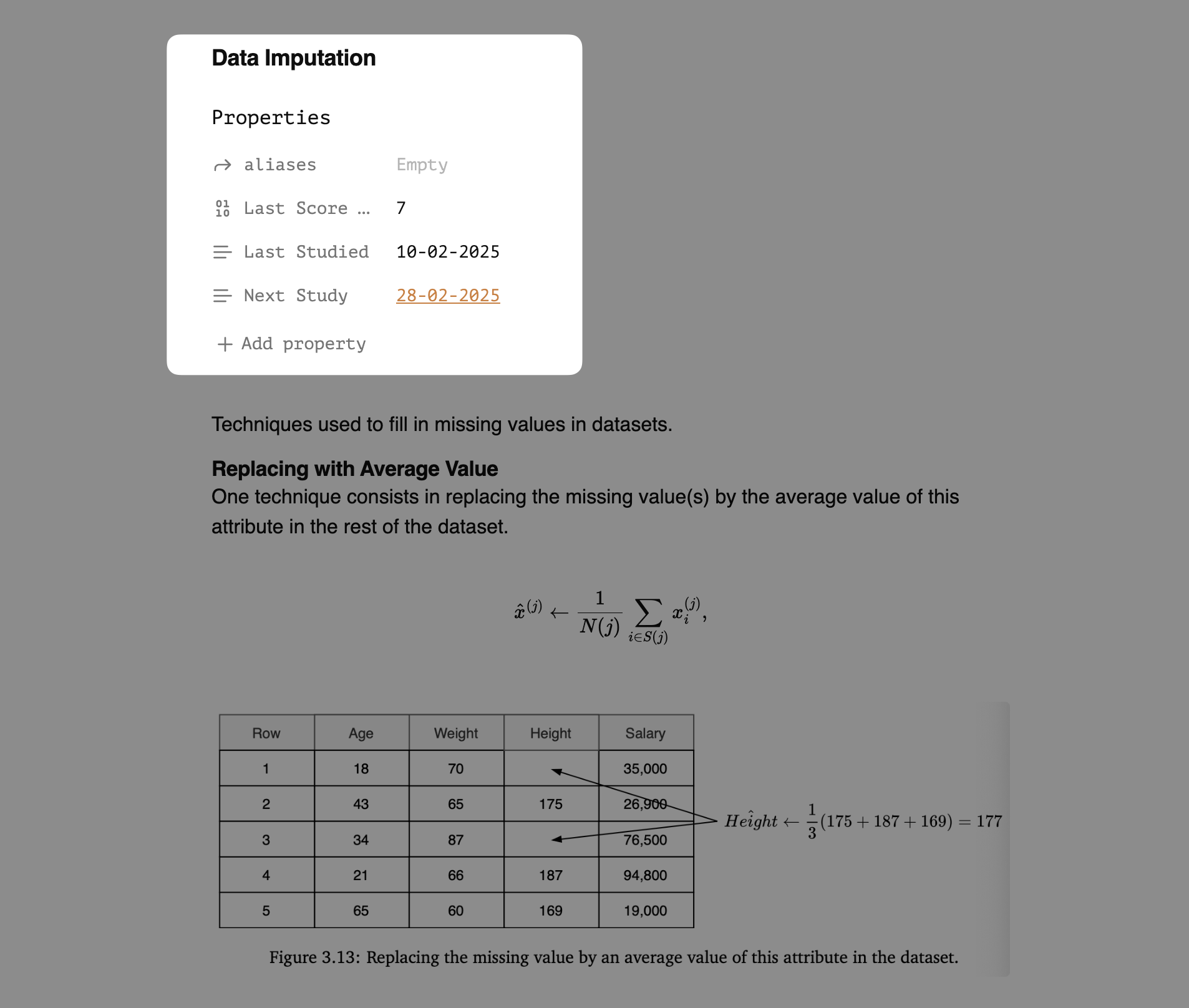 Every time I study a topic, I update the Last Studied to that day and give myself a score. Based on that score, I determine when I should study the topic again. Here’s how Obsidian makes this super easy to organize and keep up with:
Every time I study a topic, I update the Last Studied to that day and give myself a score. Based on that score, I determine when I should study the topic again. Here’s how Obsidian makes this super easy to organize and keep up with:
Obsidian has a plugin called Daily Notes where it lets you create a note for each day, with the date as the title. When you set the date for Next Study as a link in the note, it shows up on the Daily Note as a Linked Mention.
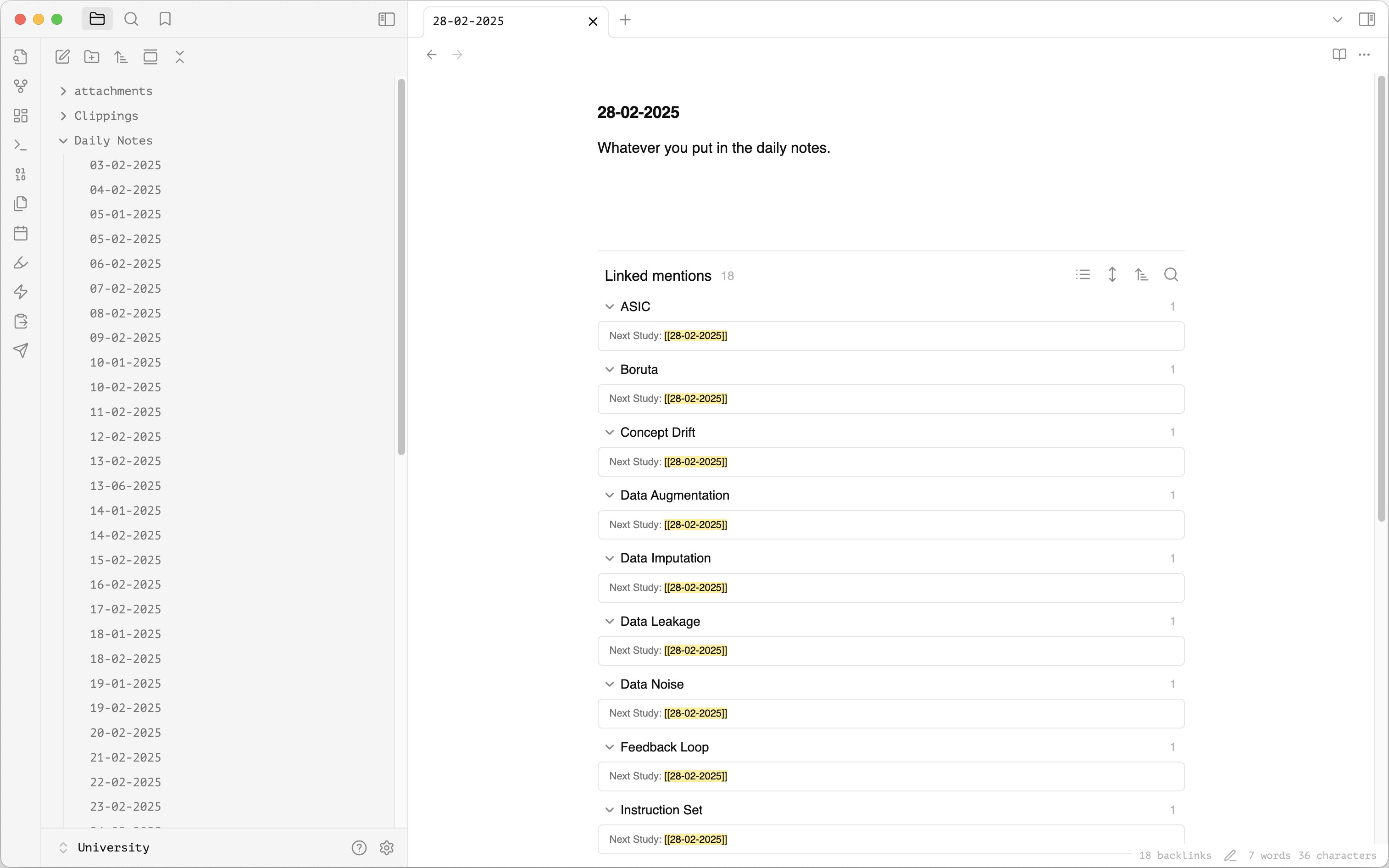 So every day, you just create/open your daily note, study the topics shown there and update the properties, and you have an automatic spaced repetition schedule.
So every day, you just create/open your daily note, study the topics shown there and update the properties, and you have an automatic spaced repetition schedule.
How fun!!
Spaced Repetition alone isn’t enough though. You have to study in an effective way that makes you understand and remember the material for longer. This is where you should use Active Recall.
Active Recall
Basically, instead of just reading your notes, you should first try to test yourself to see how much you remember. This will show you the gaps in your knowledge and how much you really understand and remember if you were to take the exam now.
You can use something like Anki, or just try to remember everything before reading a note in Obsidian.
I built an app called QuizBuilder.ai to make an online multiple choice quiz from things you upload. Since Obsidian is just a bunch of markdown files, you can drag and drop them into QuizBuilder.ai and test yourself on that material. My friends used it for an exam and they got really good grades.
Teaching to Others (Feynman Technique)
Teaching others is Active Recall on steroids. You have to explain something in a simple way that makes sense to someone else. They will ask you questions when they don’t understand something. If you can’t answer, you’ve found a gap in your knowledge which you have to fill by studying and practicing more.
If you frame this as tutoring, you can even get paid to do this which is incredible. If you don’t have someone to teach, you can write a blog as if you are teaching it to someone. That’s what I try to do in the “Learning” section of my website.
With all of these stuff, there’s an important question: when do you do all of this stuff? Here’s a rough routine I’ve come up with that lets me do these things on autopilot.
The pre-class skim
I take like 15-20 minutes before a class to look through the material that will be taught just to get a feel. Any important words, any images, etc. Sometimes I just upload the slides or book chapter to Gemini and ask for a brief summary of key insights. This is one of those asymmetric activities that doesn’t take much time but is very effective:
- It will prevent you from getting lost in the lecture
- It will let you solidify your vague ideas in the lecture
- It will enable you to ask good questions
- And it will make you look smarter to your professor and class. If the class doesn’t post the material before the class, you can just look up the syllabus to search the topics yourself, or skim the book chapter with AI.
The post-class recap
After the class, I try to make sure I’ve understood everything. I ask any questions I have to the professor or AI. This prevents me from stacking topics I haven’t understood until it’s too big to manage.
Usually, the lectures or slides can’t go deep so they link resources for more understanding. I take a look at those to see if something makes the topic “click” for me. I’ll try to find some myself, or ask ChatGPT all questions I have until I’m satisfied.
Then, I make my Zettelkasten notes.
If there are practice problems or an assignment that takes less than an hour to do, I try to do that too. It all just improves my understanding so I don’t have to “learn” again later and I can just “review”.
Paying Attention in Class
Obviously, this won’t work if you’re not focused in class. Your parents (or you) have paid for the class and you might as well pay attention if you have to learn the material anyway. You also build rapport with the professor by asking/answering questions and participating.
This is another one of the asymmetric activities: participation in class doesn’t really take any effort but makes the professor likes you and give you the benefit of the doubt in cases where it might matter. That’s huge.
I force myself to put away my laptop. It’s just impossible to not get distracted. If I need to take notes, I use my remarkable, or paper. It keeps me more engaged.
If it is allowed, I try to record the class on my phone and then dump it into an AI to get the key points and make my Zettelkasten notes. This lets me just focus on listening and understanding without stressing about taking notes.
Learning By Doing
For coding or similar kinds of stuff, you learn by doing. Trying to implement different types of Feature Encoding yourself will make you understand encoding much faster and better than if you read it in a book. It gets burned into your brain because you physically went through it, typing every character.
Obviously if you use AI to do this for you, you are wasting your time. The learning comes from doing, failing, fixing, repeat. Not from getting it right.